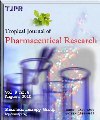
|
Tropical Journal of Pharmaceutical Research
Pharmacotherapy Group, Faculty of Pharmacy, University of Benin, Benin City, Nigeria
ISSN: 1596-5996
EISSN: 1596-5996
Vol. 16, No. 5, 2017, pp. 967-973
|
 Bioline Code: pr17124
Bioline Code: pr17124
Full paper language: English
Document type: Research Article
Document available free of charge
|
|
|
Tropical Journal of Pharmaceutical Research, Vol. 16, No. 5, 2017, pp. 967-973
| en |
Formulation and development of colon-targeted mucopenetrating metronidazole nanoparticles
Kaur, Sukhbir; Narang, RK & Aggarwal, Geeta
Abstract
Purpose: To formulation and develop colon-targeted mucopenetrating metronidazole nanoparticles.
Methods: Metronidazole-loaded chitosan nanoparticles with a pH-sensitive polymer, hydroxyl propyl
methyl cellulose phthalate (HPMCP), were prepared by ionic gelation technique and then coated with
Eudragit S100 by solvent evaporation method. The nanoparticles were optimized using one variable at
a time (OVAT) approach. Further, the nanoparticles were evaluated by scanning electron microscopy
(SEM) and zeta sizer, as well as for in-vitro release. Muco-adhesion was evaluated by modified
bioadhesion detachment force measurement balance and muco-penetration of fluorescein
isothiocyanate (FITC) labeled optimized nanoparticles was determined by microscopic technique
Results: Morphological assessment results revealed smooth, spherical particles with homogeneous
distribution and polydispersity index (PDI) of 0.213. The optimized formulation showed particle size of
202 ± 27 nm, zeta potential of 26.9 ± 2.4 mV as well as and entrapment efficiency of 79 ± 5.4 %. There
was significant difference in drug release between coated (8.46 ± 2.49 %) and uncoated (28.96 ± 4.04
%) nanoparticles at the 5th h in simulated gastric conditions. Muco-adhesion data revealed that
uncoated nanoparticles (14.98 x 103 dyne/cm2) showed higher muco-adhesion detachment force
compared to coated (12.34 x 103 dyne/cm2) nanoparticles. Muco-penetration results confirm the
retention (for up to 12 h) of the developed formulation at the target site for enhanced therapeutic
exposure of the entrapped drug.
Conclusion: Eudragit S100 coating of chitosan-HPMCP nanoparticles promotes efficient drug targeting
and thus provides a strategy for treating mucosal infections. .
Keywords
Metronidazole; pH-sensitive nanoparticles; Hydroxylpropyl methylcellulose phthalate; Ionic gelation; Mucoadhesion; Mucopenetration; Intestinal infection
|
| |
© Copyright 2017 - Pharmacotherapy Group, Faculty of Pharmacy, University of Benin, Benin City, 300001 Nigeria.
Alternative site location: http://www.tjpr.org
|
|
